Since its establishment in 1993 and first season in 1996, Major League Soccer is the most dynamically growing league in the world. Thanks to the arrival of well-known veterans from Europe and the country’s successful World Cup runs, the average attendance and TV views hit a new peak every year. With more revenue and money at stake than ever, the front offices and the players are under constant pressure to perform well. In a competitive environment where even newly established teams are added to the league every season, owners could debate to what degree youth development should be part of their investment plan.
The sudden and permanent shutdown of the U.S. Soccer Developmental Academy (USSDA) has left a void in the life of football academies. As it stands now, the 200 previously featured youth teams won’t have an organized league to play in. Whether the Soccer Federation decides to go on with another format or give greater freedom to the member clubs, it is imminent to improve the development project. To understand the situation better, this data analysis will examine the U.S. youth programme with the help of statistical data.
The American dream by the numbers
As a result of continuous and systematic work, the football standards in North America has improved at an unprecedented rate. However, the league has arrived at crossroads in terms of its future sustainability. As per the 2019 report of FIFA, there are currently 1,833 male professional football players in the U.S out of the total 128,983 worldwide.
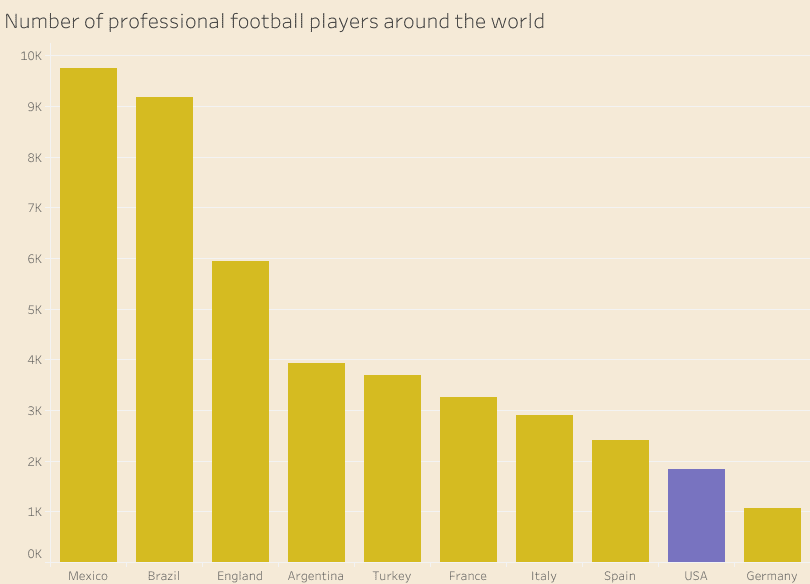
While there is not a direct correlation between these numbers and the success in youth development (as seen with Germany) out of the listed countries, the U.S has the biggest potential to expand in the future. This is a key point to our argument. MLS misses at least 2-3,000 athletes from their player pool to think about becoming a powerful challenger of Europe. The figure is too high to rely on transfers alone so the matter needs to be addressed internally.
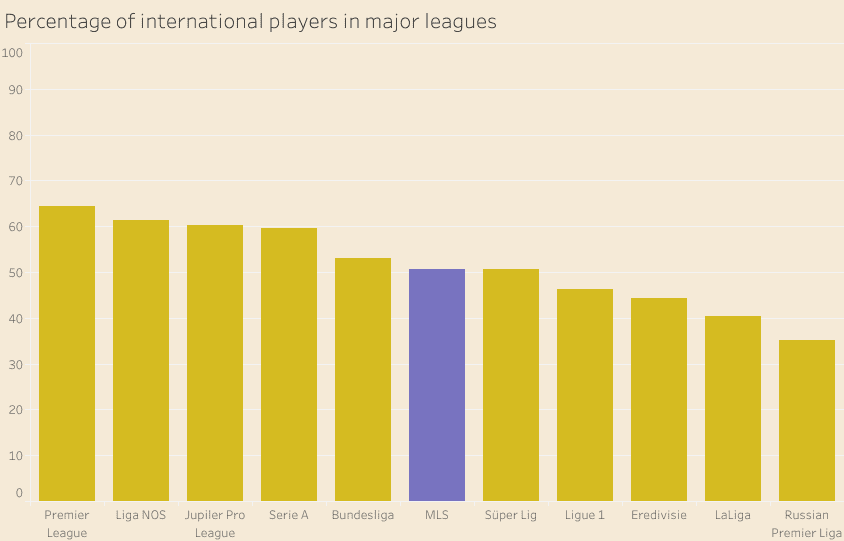
MLS could go either way from here. However, the main initiative should be to find a feasible way to grow as a league and provide a competitive environment for the clubs. In any place around the world where football arrived during history, growth was achieved by well-established academies. While football did arrive in the U.S. almost 30 years ago, the argument is still valid up until this day.
The homegrown advantages
The MLS rules make it easy to classify a player as homegrown. He has to spend at least one year in a club’s academy starting before the age of 15 while he also has to live in the club’s territory. As an academy graduate, he can be handed a ‘homegrown contract’ for his efforts and then he is added to the team’s roster.
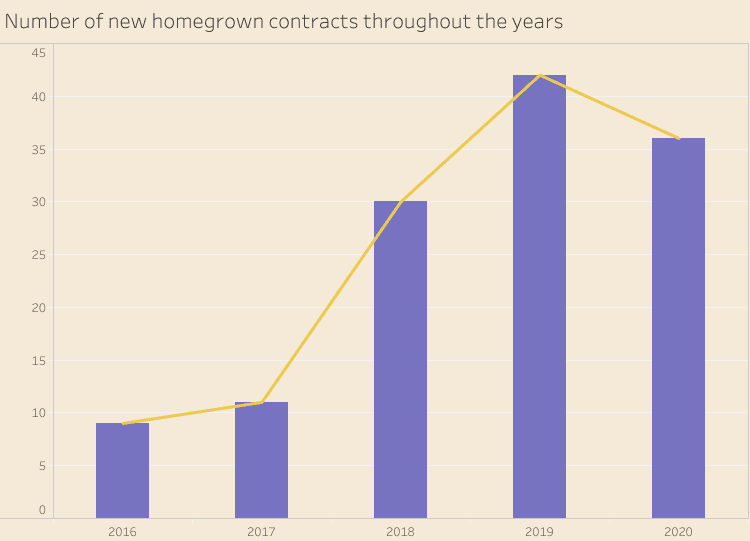
From a club’s perspective, there are extra benefits other than signing a talented local player. Not only can they fill up unlimited roster spots but these homegrown players also earn less at the beginning of their careers based on the MLS rules regarding different salary categories. Moreover, the league encourages this type of investment by providing subsidy from a league-wide allocation pool when signing these athletes to their first contract. Therefore, if a club primarily focuses on their youth development, they could reallocate the available money under the salary cap into other areas of the squad and create a balanced team.
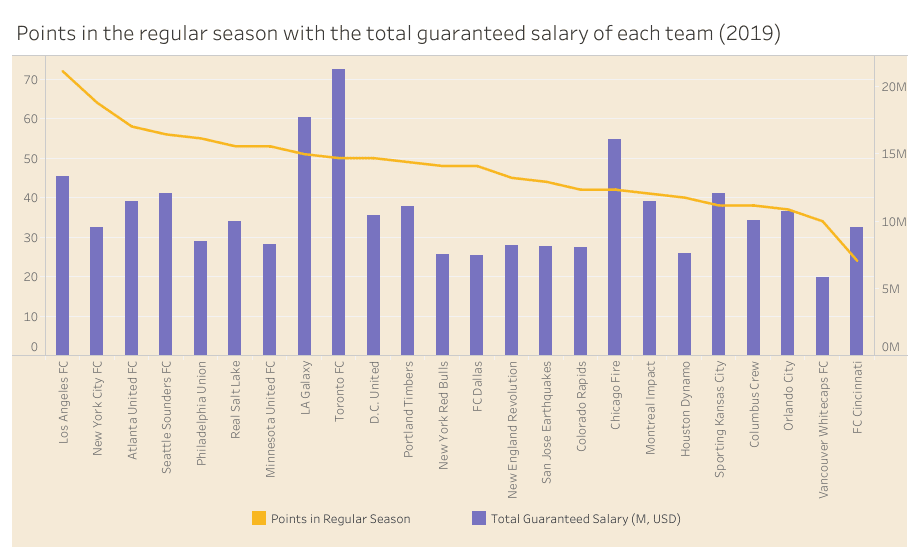
The chart can give us a sense of efficiency with the figures showing how the teams fared last year relative to their annual payroll. Los Angeles FC scored a record 72 points in the campaign but New York City FC, Philadelphia Union and Minnesota United could enjoy success in the ‘cheapest way’. While the distribution of the collective salary can differ per player categories, it is worth specifically to focus on the homegrown contracted players for the sake of our argument.
Dallas leading the way
When we think about a prime example in youth development, it is always FC Dallas that can come into our minds first. They began their work with youngsters back in 2008 having joined the USSDA competition. The academy grew under the influence of Chris Hayden who was named director in 2019. As for the results, they already started coming with an MLS Cup Final appearance in 2010 and only seven years after the establishment of the academy, Dallas won the Western Conference in 2015 with eight homegrown players when the league average only stood at three. In 2019, they finished seventh but through the years, they continued to dominate in the conference in terms of local athletes and they even increased the numbers of contracts in 2020.
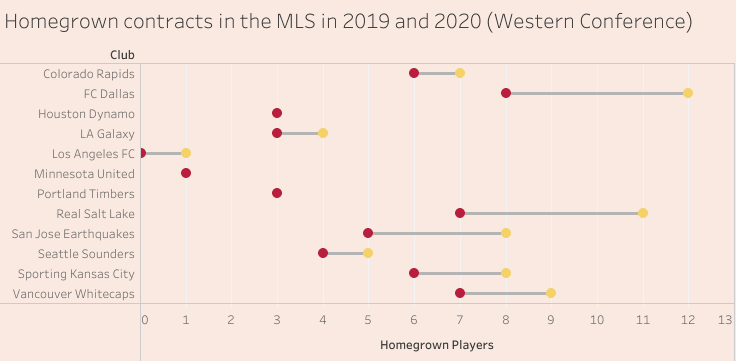
We cannot forget about Real Salt Lake (RSL) who keep up with Dallas as a younger team, only founded in 2004. The big turnaround in youth development came in 2018 when the Zions Bank Real Academy opened. As an instant result, the club’s affiliate, Real Monarchs with numerous homegrown players from RSL won the USL Championship in 2019. Meanwhile, the first team ended up in third place in MLS and got all the way to the Conference Semifinals.
Rebuilding from the ashes
There is a team in full rebuild mode in the Eastern Conference, the Chicago Fire. Their story can be encouraging for other clubs but we have yet to see the result of the current takeover by European directors. Since a change in ownership in 2018, Chicago has doubled their homegrown players and now they are ready to build a young team for the long run. The masterminds behind these movements are sporting director Georg Heitz and head coach Raphaël Wicky, both coming from previously working in Swiss football.
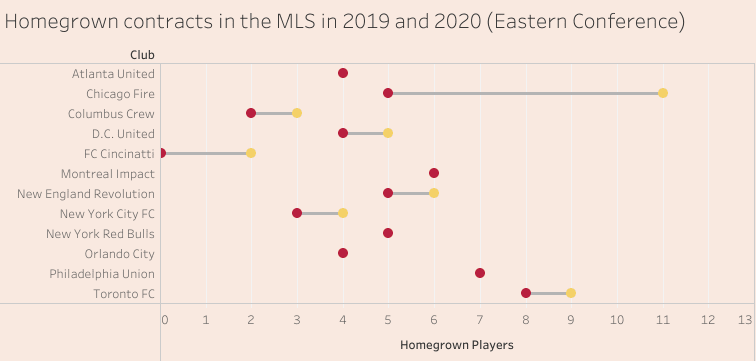
The second leading force behind Chicago in terms of the number of contracts is Toronto FC. There is a small discrepancy in Toronto’s performance and payroll from last year even though they had eight homegrown players. This can be explained by the equal presence of high earners on the roster, like Jozy Altidore or Michael Bradley. Currently, there are three Canadian clubs in MLS (Toronto, Vancouver and Montreal) and all contribute to the improvement of the league. The same rules apply to Canadian players for homegrown classification while these sides seem to prefer playing local athletes (8.0 on average in 2020) more than in the U.S (5.4 on average).
Stepping onto the pitch
It is one thing to examine the number of youngsters signed on the first team but it doesn’t tell a whole lot about the end product. Therefore the players’ quality and ability to start games will be examined in this part of the analysis. As the league only survived two rounds in 2020, we are going back to 2019 to see how homegrown players performed.
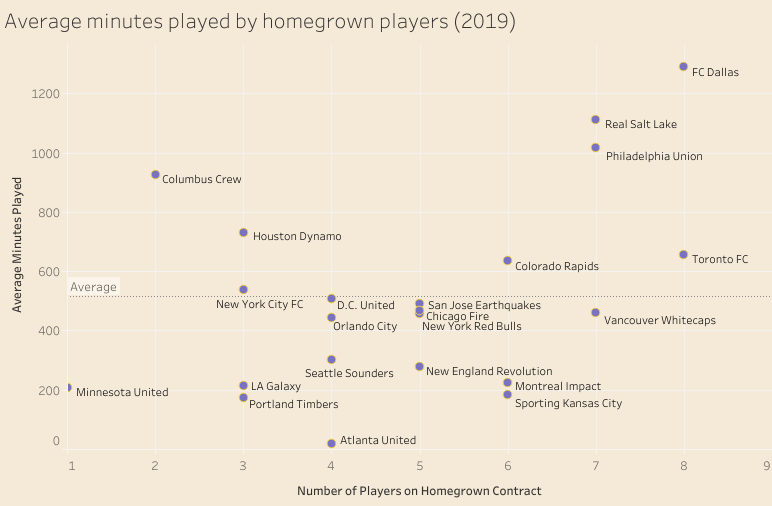
This chart represents to what extent teams used their local youngsters. Besides the previously mentioned teams, Philadelphia and Colorado assigned these players to greater roles while Houston Dynamo, Columbus Crew and New York City FC were the only other clubs to reach the 515 minutes of average playing time in 2019. Although Vancouver and Atlanta signed several young talents, they are well below the expected contribution in minutes at the moment.
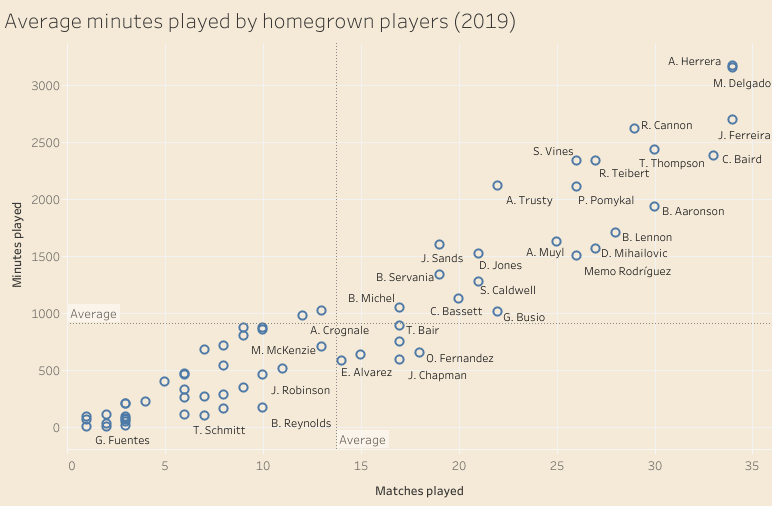
On an individual level, 22-year old Real Salt Lake defender Aaron Herrera won with 3,175 minutes played. He was one of the three homegrown players who were featured in all regular-season games with Toronto’s Marky Delgado (3,153 minutes) and Jesús Ferreira (2,701 minutes) from Dallas following. It is interesting to notice that an equal number of defenders and attackers appear on the higher end of the statistics. Less surprisingly, a good chunk of the heavily used players are members of the U-23 national team.
High performers and high potentials
As we turn onto the last part of the analysis, we should focus on individual performances. By highlighting three key areas in the statistics, we aim to give a basic perspective on which homegrown talents produced elite numbers in 2019. After evaluating the data from the attacking, middle and defensive third, we can determine how the future of football in the U.S. should shape up.
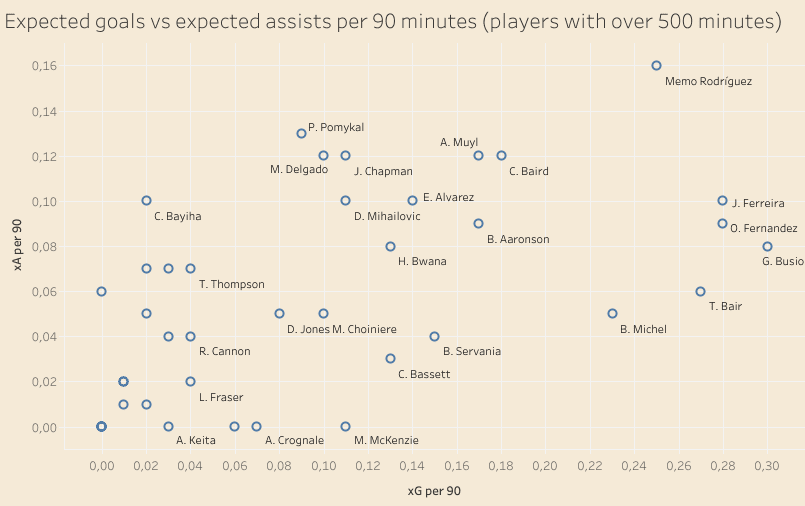
Memo Rodríguez enjoyed the most productive campaign last year and stood out from the rest of the pack. He repaid the trust of Houston with combined 0.25 expected goals and 0.16 expected assists per 90 minutes. 17-year old Manchester United and Inter target, Gianluca Busio brought the best xG per 90 figure on the table with 0.30, capping a phenomenal season at Sporting Kansas City. He was followed by Ferreira and New York Red Bull’s own Omir Fernandez (both with 0.28 xG per 90). As for the expected assists, Paxton Pomykal’s (0.14 xA per 90) name is worth mentioning as Dallas is represented again.
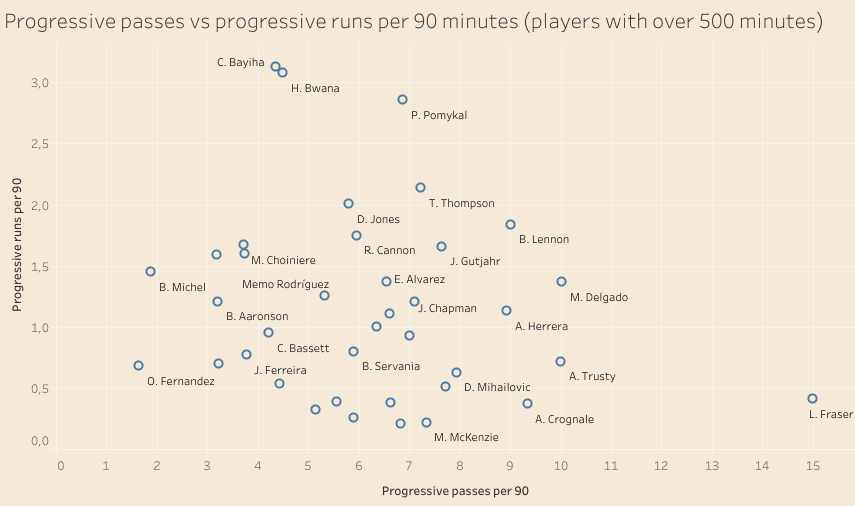
We investigated also which players advanced the ball most efficiently from the midfield. Liam Fraser, a Canadian international appears with 15 progressive passes per game, by far the most from any homegrown athletes. On the other end of the chart, Montreal Impact winger, Clement Bayiha (3.13 progressive runs per 90) and Seattle Sounders attacking midfielder, Handwalla Bwana (3.08) are neck and neck in progressive runs and dribbles per game.
Above-average in all four metrics visualized, emerges Efraín Álvarez who deserves to be recognized as one of the most exciting rising stars in the league. AC Milan star Zlatan Ibrahimovic himself called him ‘the best young talent in MLS by far’.
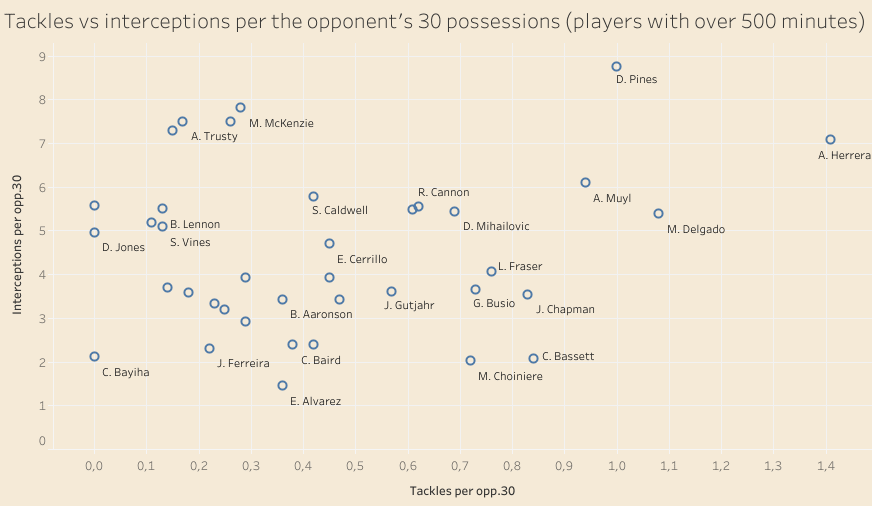
Once again, Herrera tops the defensive chart (1.4 tackles and 7.1 interceptions per 30 attacking actions) as he proved his maturity and as a result, he earned a long-term contract from Real Salt Lake. Donovan Pines, D.C. United’s 6 foot 5 inches athletic defender made the transition into MLS and dominated in the air. His long frame allowed him to intercept 8.75 balls additionally to the 1.0 tackles per opp.30. NYRB midfielders, Alex Muyl and Delgado led the homegrown midfielders in defensive actions.
Conclusion
In this data analysis, we dived into football overseas. Starting from all professional players in the U.S, we worked ourselves down to the level of young athletes who are currently under homegrown contracts. In the meantime, we discovered the clubs who are leading the way in youth development and constantly producing talents to the nation. Dallas are clear favourites and on the right path with Real Salt Lake, Philadelphia and Toronto closely following. Chicago Fire were the latest club to take crucial first steps towards an academy-centred rebuild.
We put MLS and more importantly the U.S. academy system under the microscope. In light of the current events at USSDA, we felt the need to provide thoughts on how the league could go forward in the future. We believe that the most sustainable way to form this league into a true power in football leads through national youth development. While there is a wider competition among major sports for local talents, every state holds great potential to be scouted more thorough than ever before. The team and individual data support the idea very much, revealing the great quality this post-2000 age group possesses.
The Soccer Federation along with MLS did a great job so far to grow the league into what it is today. However, the hardest part comes now when the functioning system needs to be improved for even greater progress in the future.

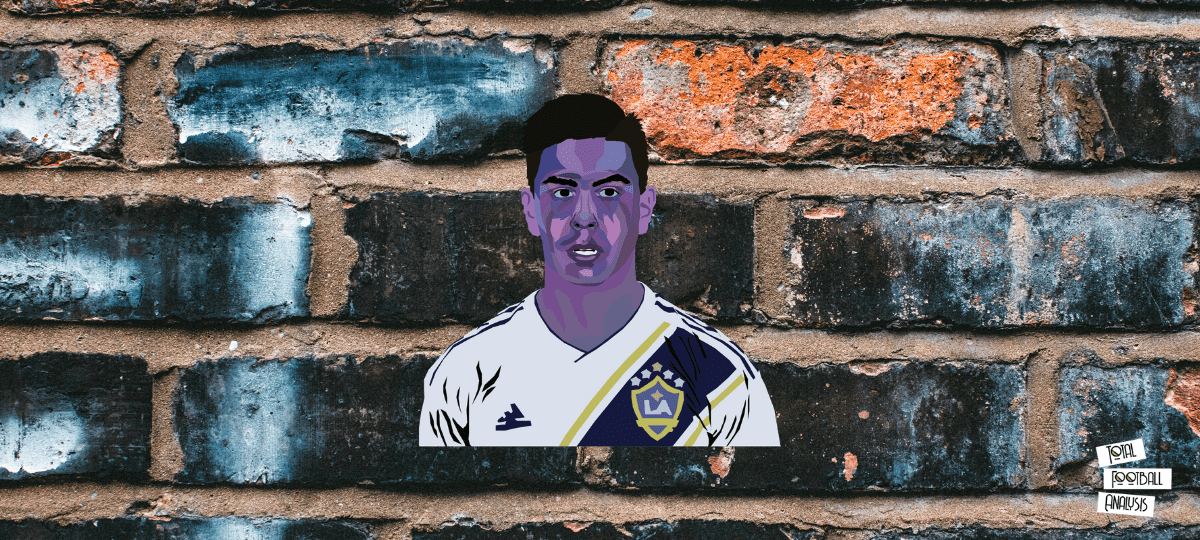



Comments